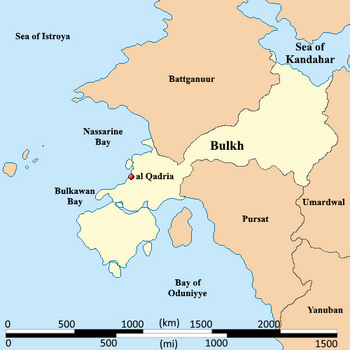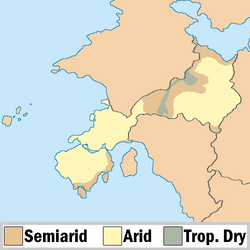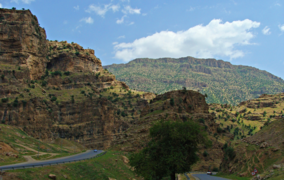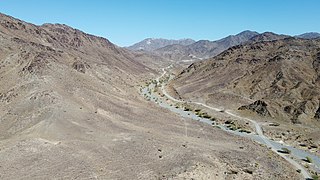Bulkh: Difference between revisions
m (→Climate) Tag: 2017 source edit |
m (→Geography) Tag: 2017 source edit |
||
| Line 122: | Line 122: | ||
===Climate and environment=== | ===Climate and environment=== | ||
{{Further|Prevailing Winds}} | |||
[[File:Bulkh Climate Map.png|250px|right]] | [[File:Bulkh Climate Map.png|250px|right]] | ||
Because it is a coastal state that is on the edge of the The [[Great Kavir]] desert Bulkh has three primary climate zones. | Because it is a coastal state that is on the edge of the The [[Great Kavir]] desert Bulkh has three primary climate zones. | ||
==Economy== | ==Economy== | ||
Revision as of 22:08, 1 February 2024
| This article is a stub. You can help IxWiki by expanding it. |
Bulkh | |
|---|---|
|
Flag | |
Motto: Unity of purpose, unity of strength | |
 Political Map of Bulkh | |
| Capital | al Qadria |
| Government | constitutional republic |
• The Most Elected Minister | Rahani Bintuta |
| Area | |
• | 796,939.342 km2 (307,700.000 sq mi) |
| Population | |
• Estimate | 1,500,540 |
• Density | 1.88/km2 (4.9/sq mi) |
| GDP (nominal) | estimate |
• Total | $3.66 billion |
• Per capita | $2,436.46 |
| Date format | dd-mm-yy |
| Driving side | right side |
Bulkh, officially the Representative Republic of Bulkh, is a minor power sovereign country on the southwestern coast of the Daria region in Audonia. It is bound by the Sea of Kandahar in the north, Battganuur to the north, the Nassarine Bay and the Bulhkawan Bay to the west, the Bay of Oduniyye to the south, and Pursat to the southeast. It came to its modern iteration after the Emirati War, in 1897 both geographically and politically. It is a constitutional republic with consociational representation, shared between the Arab Muslim population, Bedouin nomads, and the polity of Christians. While suffrage is universal and by secret ballot, it is still common for voters to generally follow their tribal leaders lead on issues. Bulkh is a member of the League of Nations, and the International Red Cross and Red Crescent Movement.
Its primary exports are crude oil, Construction aggregate, fish, and cork. It maintains a capitalist economy but with certain controls and subsidies around critical industries like food, water, energy, healthcare, and transportation, which are typically managed as a public-private ventures.
Many scholars have criticized its governance, economy, and politics, arguing that it is merely a client of Burgundie.
Geography

-
Farming in Bulkhan interior
-
Southern mountains, Baqunah Mountain Range
-
Wadi in the Great Kavir desert
-
Coastal community
Climate and environment

Because it is a coastal state that is on the edge of the The Great Kavir desert Bulkh has three primary climate zones.
Economy
Industries and Sectors
Bulkh is an industrialized nation with a strong manufacturing sector. It's close ties with Burgundie have led to a number of agreements with has allowed Burgoignesc companies to establish manufactories in Bulkh while paying local salaries, however all manufactories must comply to Burgoignesc health and safety standards.
Manufacturing
Ship building has risen to the forefront of Bulkh's manufacturing sector. It serves as an excellent foil to Burgundie's more expensive ship building industry.
Agriculture
Although Bulkh is mostly arid, the nation is a major agricultural producer and exporter, with over 325,300 employed in agriculture, forestry and fishing. Because of the climate the largest agricultural subsector is grazing (sheep, goats, and Zebu cattle) in the large semiarid zones. Across the country there is a mix of irrigation and dry-land farming. Plantation farming for crops like tea, rice, sugar, and rubber exist in the heavy rainfall coastal zones but the heavy winds from the interior desert keep much of the moisture restricted to the coast. Pisciculture is also a formidable subsector with sizable domestic and deep-water fleets, farms, and sustenance communities. The success of Bulkh to become a major agricultural power despite the odds is facilitated by its policies of long-term visions and promotion of agricultural reforms that greatly increased the country's agricultural industry.
Infrastructure
Air
Bulkh has one international airport the Malik International Airport.
Roads and rail
Louage
A louage is a minibus shared taxi in many parts of Daria that were colonized by Burgundie. In Burgoignesc, the name means "rental." Departing only when filled with passengers not at specific times, they can be hired at stations. Louage ply set routes, and fares are set by the government. In contrast to other share taxis in Audonia, louage are sparsely decorated. Louages use a color-coding system to show customers what type of transport they provide and the destination of the vehicle. Louages with red lettering travel from one state to another, blue travel from city to city within a state, and yellow serves rural locales. Fares are purchased from ticket agents who walk throughout the louage stations or stands. Typical vehicles include: the MILCAR Jornalero, the TerreRaubeuer Valliant 130, and the CTC M237-07.
Military
The military of Bulkh is small but highly professional. It is compromised of three branches the Army (land), the Maritime Defense Force (navy and coast guard), and the Republican Escadrille (air force and ostensibly space force).
The Army had 5 brigades (3 infantry, 1 armored, and 1 air assault). It was reformed entirely during Operation Kipling eschewing many archaic and tribalistic traditions. It is viewed as the safeguard of secular republicanism and it's traditions and virtues follow those concepts. The army's strategic objectives are all defensive in nature but it's air assault brigade has some minor expeditionary capacities, within a limited scope. It is postulated that Bulkh could launch expeditionary operations against Battganuur, Chaukhira, Pursat, Umardwal, and Yanuban, although sustainment would become an issue after a week of sustained fighting.
The Maritime Defense Force (MDF) is formed around 4 destroyer squadrons, with a total of 8 destroyers, 18 frigates, 29 frigates and avisos, 63 littoral patrol craft, 5 ocean going tugs, 2 hydrological survey ships, and 2 dredgers. It also has an amphibious assault craft and 3 replenishment oilers that it purchased from Burgundie in the late 1990s through the mid 2020s which constitutes it's only expeditionary capability. The MDF also has a modest air wing with 13 fighter/torpedo bombers, 19 fighter/interceptors, 17 maritime patrol/meteorological survey aircraft, and 2 AWACS.
The Republican Escadrille is a force of 7 air wings, 4 fighter/interceptors wings, two fighter/bomber wings, and one AWACS/Electronic Warfare wing. The Escadrille also oversees the countries Strategic Forces and it's arsenal of ICBMs, the true number is unknown but it is estimated that it is around 47.
See also



